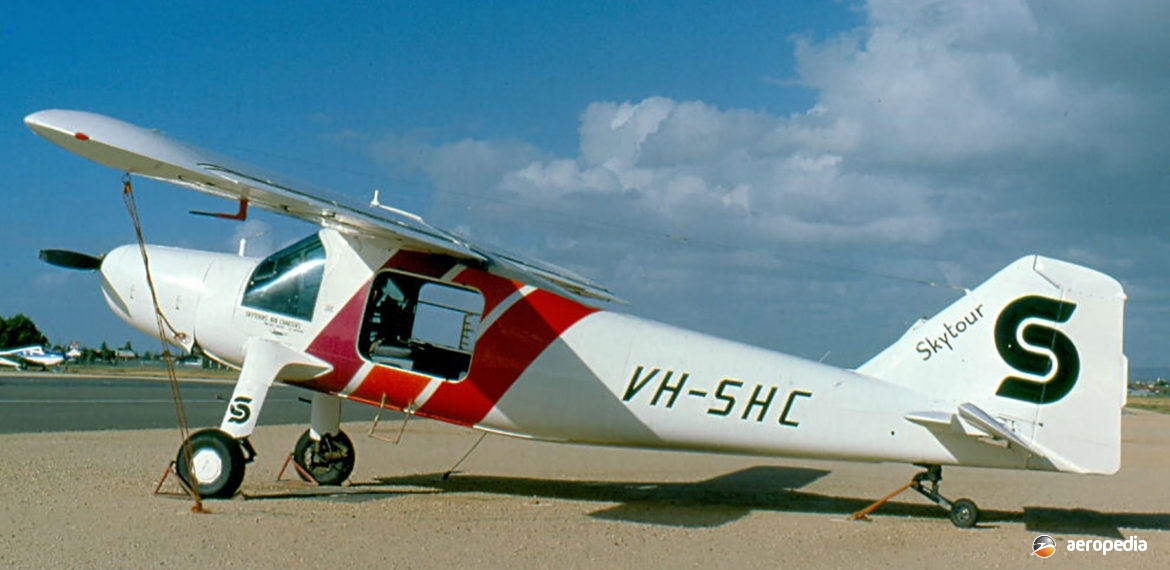Photograph:
Dornier Do-27 VH-SHC (c/n 519) at Parafield, SA in January 1975 (David C Eyre)
Country of origin:
Germany
Description:
Light utility transport
Power Plant:
(Do-27A-4)
One 201 kw (270 hp) Lycoming GO-480-B1A6 six-cylinder horizontally-opposed air-cooled engine
Specifications:
- Wingspan: 12 m (39 ft 4½ in)
- Length: 9.6 m (31 ft 6 in)
- Height: 3.5 m (11 ft 6 in)
- Wing area: 19.4 m² (208.82 sq ft)
- Max speed at 1,000 m (3,280 ft): 226 km/h (140 mph)
- Cruising speed at 75% power: 210 km/h (130 mph)
- Cruising speed at 65% power: 175 km/h (109 mph)
- Minimum speed with 45° flap: 50 km/h (31 mph)
- Time to 1,000 m (3,280 ft): 2.6 mins
- Time: to 3,000 m (9,840 ft): 12
- Ceiling: 5,499 m (18,040 ft)
- Cruising range: 869 km (540 miles)
- Take-off run: 190 m (623 ft)
- Landing run: 90 m (295 ft)
- Fuel capacity with auxiliary tanks: 364 litres (80 Imp gals)
- Empty weight: 1,107 kg (2,440 lb)
- Loaded weight: 1,850 kg (4,070 lb)
History:
The Dornier Do-27 was the first German military aircraft of post-war design to achieve quantity production, and it saw service with the air forces of West Germany, Switzerland, and South Africa, as well as the armies of Germany and Sweden. The prototype, known as the Do-25, flew for the first time on 25 June 1954 and, fitted with a 112 kw (150 hp) ENMA Tiger engine, was built in Spain. The prototype Do-27 flew for the first time on 8 April 1955 and the type entered production at the Dornier-Werke GmbH facility. Thereafter some 50 examples were built in Spain by CASA for the Spanish military, and the remaining production of some 620 aircraft took place in Germany. The first production machine was flown on 17 October 1956.
A number of variants were produced, along with a variety of engines. Models included the Do-27S seaplane; Do-27Q six-seat civil aircraft; Do-27A which could carry five persons and was readily adaptable for the carriage of freight; D0-27B dual control trainer; and the D0-27H and Do-27Q for civil use.
The Do-27 was initially designed to meet a Spanish Air Ministry specification for an air-observation post and liaison monoplane with emphasis placed on slow flying capabilities, good visibility, ease of loading, and easy to maintain. It was a high-wing cantilever monoplane of all-metal construction, except for the rear part of the wing which, like the tailplane and rudder, was fabric covered. Accommodation was provided for up to six when used as a utility transport, or four when used as an observation post or ambulance. Power plants available included the 168 kw (225 hp) Continental O-470, 201 kw (270 hp) Lycoming GO-480 B1A6, and 254 kw (340 hp) Lycoming GSO-480-B1B6. One was experimentally fitted with a Turbomeca Astazou turboprop.
Eight examples of the Model Do-27-H4 have appeared on the Australian Civil Aircraft Register over the years, and seven of these spent most of their flying lives in Papua New Guinea, where their strength was found to be of great advantage. The two main operators were Territory Airlines and the Catholic Mission of the Divine Word. As with most single-engine types in the mountains of New Guinea, attrition was high and a number were lost in accidents.
One is reported to have been allotted the registration VH-SHA and is said to have been imported in March 1965 for the Catholic Mission but was written off during unloading at Wewak, PNG when it was dropped into the sea. However, it would seem that this is fallacy and no VH-SHA was imported for the Catholic Mission and no Do-27s were dropped into the harbour.
The aircraft imported were: a Do-27A-4 VH-SHB (c/n 488 – ‘Paderborn’) which operated with the Catholic Mission but crashed on 29 June 1967 at Sassoya Gap, NG.
A Do-27A-4 VH-SHC (c/n 519) which operated with the Catholic Mission, later operating with Skytours, and then Peninsula Air Services, ending up in Tasmania as VH-UIE before being exported back to New Guinea in 1974, where it later became P2-UIE but was exported to Germany where it initially became D-EBTF, later D-ENTE. It was then used to carry out an animal expedition to Africa in 1958-1959 but suffered an accident in Tanzania on 10 January 1959 and had to be returned to Germany for a rebuild.
Another Do-27A-4 VH-SHD (c/n 526) operated with the Catholic Mission in September 1965 but crashed at Kunjingini, PNG on 22 August 1969.
A Model Do-27Q-4 VH-IHS (c/n 2075) also operated with the Catholic Mission in March 1961 but crashed on 26 July 1968 at Kunjingini, PNG.
A Do-27H-2 VH-GKE (c/n 2076) operated with Territory Airlines in March 1961. In February 1962 it became VH-EXA with Executive Air Services, then it returned to Territory Airlines. Later in 1962 it went to the Catholic Mission, but crashed on 3 September 1964 at Dumpu, PNG.
A Model Do-27H-2 VH-CHR (c/n 2077) also operated with the Catholic Mission in April 1961 but crashed at Gisuaka, PNG in June 1961.
Another Do-27H-2 VH-AMQ (c/n 2097) operated with Territory Airlines in November 1961 but crashed at Chuabe, PNG on 12 June 1962.
None has survived in this region, the last aircraft being exported to Germany as noted above.

